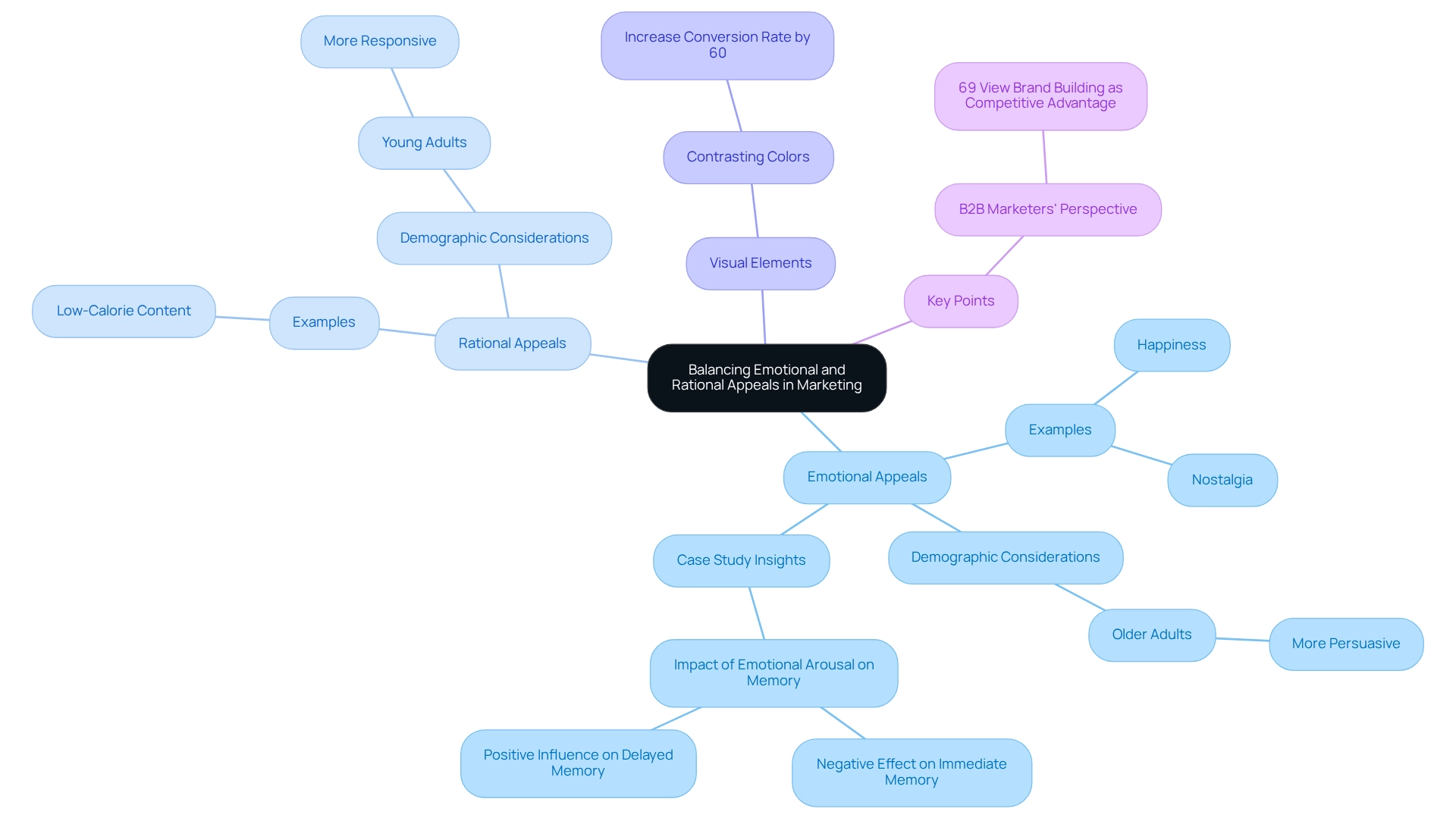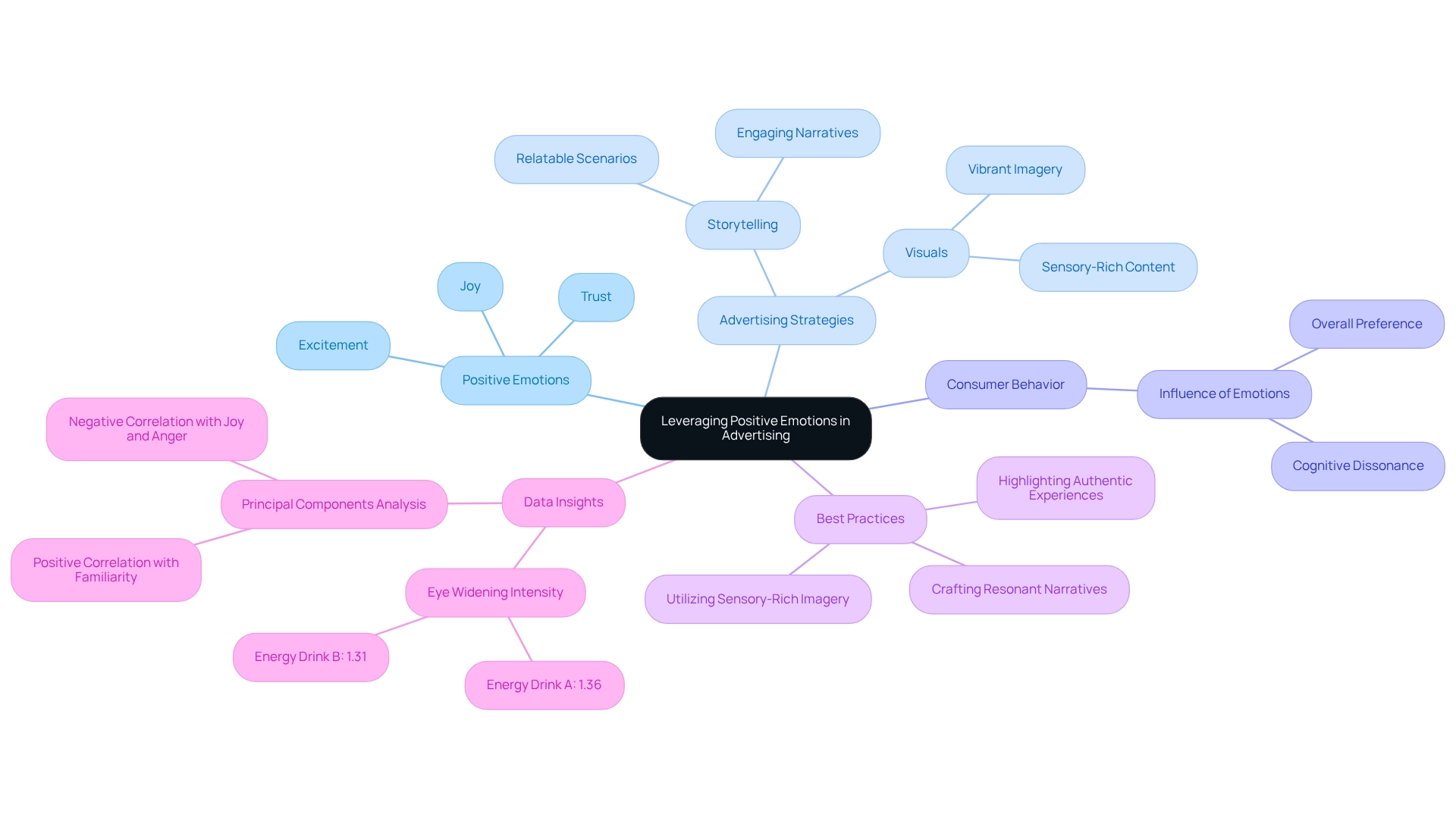Digital Branding Strategies
How to Address Consumer Cognitive Dissonance in UAE Beverage Advertising: A Step-by-Step Guide
Overview
Addressing consumer cognitive dissonance in UAE beverage advertising requires a strategic alignment of marketing messages with the health-conscious values of consumers. By leveraging emotional appeals, brands can foster meaningful connections. Understanding consumer beliefs is paramount; employing strategies such as:
- Clear messaging
- Reassurance through social proof
- Engaging content
can effectively mitigate feelings of guilt or regret associated with conflicting choices. This approach not only enhances brand loyalty but also elevates customer satisfaction.
Introduction
In the dynamic realm of beverage marketing, grasping the psychological intricacies of consumer behavior is essential. Cognitive dissonance—an uncomfortable state arising from conflicting beliefs and actions—presents a formidable challenge for brands aiming to cultivate loyalty and satisfaction among their clientele.
As consumers navigate choices that frequently contradict their health-conscious ideals, marketers must adeptly address these internal conflicts through strategic messaging and emotional engagement. By recognizing the values and beliefs of their target audience, brands can construct compelling narratives that resonate profoundly, ultimately transforming dissonance into brand affinity.
This article delves into multifaceted strategies that not only tackle cognitive dissonance but also enhance marketing effectiveness in the fiercely competitive beverage landscape.
Understanding Consumer Cognitive Dissonance
Cognitive dissonance arises when individuals grapple with discomfort stemming from conflicting beliefs or behaviors. For example, a person may prioritize a healthy lifestyle yet opt for a sugary drink, leading to feelings of guilt or regret. This internal struggle presents a significant challenge for marketers, particularly in UAE beverage advertising, where effectively [addressing consumer cognitive dissonance](https://ukessays.ae/essays/psychology /post-purchase-behavior-of-the-consumers-psychology-essay) is crucial for fostering loyalty and customer satisfaction.
To mitigate cognitive dissonance, companies like WonderEight must first acknowledge and understand the beliefs and values of their target audience. This comprehension allows for the creation of messaging that aligns with these principles, crafting a cohesive narrative that resonates with consumers. Brands such as Miranda and Quaker Oats have successfully executed comprehensive marketing campaigns focused on engaging content and impactful brand experiences, effectively addressing customer concerns and enhancing brand visibility.
In light of evolving eating habits, effective communication strategies become paramount. Brands can leverage social media and multimedia content to initiate conversations with customers, emphasizing healthier options and the benefits of informed decision-making. By categorizing content by type—such as opinion pieces or engaging visuals—brands can cater to diverse audience preferences, thereby enhancing marketing effectiveness.
While specific statistics on cognitive dissonance in the UAE drink market are not readily available, grasping the broader implications of buyer behavior remains essential. Research indicates that customers experiencing cognitive dissonance often express dissatisfaction directly to retailers and engage in negative electronic word of mouth (eWOM), which can tarnish a company’s reputation. As highlighted by Ko, An, Haan, and Yoon, “Customers who experienced cognitive dissonance reported their dissatisfaction directly to the store and participated in negative electronic word of mouth (eNWOM).”
To effectively tackle cognitive dissonance in advertising, brands should consider the following strategies:
- Align Messaging with Consumer Values: Ensure that marketing communications reflect the health-conscious values of consumers, particularly in the beverage sector.
- Utilize Positive Reinforcement: Highlight the advantages of selecting healthier options, reinforcing positive behavior among individuals.
- Create Engaging Content: Develop campaigns that resonate emotionally with individuals, making them feel good about their choices.
Moreover, understanding cultural distinctions in purchasing behavior is vital for crafting successful marketing strategies in the UAE and Saudi Arabia. By implementing these strategies, brands can enhance their overall marketing effectiveness while addressing consumer cognitive dissonance in UAE beverage advertising, ultimately influencing purchasing decisions in the competitive drink market.
Emotional Triggers in Beverage Advertising
Emotional triggers such as nostalgia, happiness, and fear significantly influence consumer decision-making in the beverage industry. Advertisements that evoke childhood memories—like family gatherings over a cherished beverage—forge strong personal connections, thereby enhancing purchase likelihood. Research indicates that 66% of customers acknowledge that their purchasing choices are swayed by the emotions they associate with a brand.
Thus, it is imperative for marketers to comprehend which emotions resonate most with their target audience and integrate these insights into their advertising strategies. By incorporating evocative imagery, thoughtfully selected music, and compelling storytelling, brands can effectively elicit the desired emotional responses. Nostalgia-driven campaigns, in particular, have proven to be highly effective, as they tap into individuals’ treasured memories, making them more receptive to the brand’s message. As sentiment-driven marketing continues to gain momentum—81% of marketers plan to increase their investment in human-focused strategies—it becomes crucial to leverage these psychological triggers to create impactful advertisements that resonate deeply with consumers.
Case studies reveal that affective marketing can enhance conversion probability by up to 70%, underscoring the necessity of crafting advertisements that not only inform but also connect on a personal level. As Percy T. aptly states, “We should leave behind a good place for our children and grandchildren,” emphasizing the importance of creating positive legacies through branding. By focusing on personal connection, brands can amplify their advertising effectiveness and foster lasting customer loyalty.
Balancing Emotional and Rational Appeals
To effectively balance psychological and rational appeals in marketing, marketers must first grasp their audience’s needs and preferences. Emotional appeals serve as powerful instruments for capturing attention and fostering a connection with buyers, whereas rational appeals deliver essential information that supports purchase decisions. For instance, a beverage promotion may depict a refreshing drink enjoyed at a summer picnic, evoking feelings of happiness and nostalgia (affective appeal), while simultaneously highlighting its low-calorie content to resonate with health-conscious individuals (logical appeal).
Research demonstrates that ads targeting emotions are processed distinctly by the brain compared to those appealing to logic, as noted by neuromarketing expert Roger Dooley. By skillfully integrating both types of messaging, marketers can construct a more holistic narrative that effectively addresses consumer cognitive dissonance in UAE beverage advertising. This approach reassures consumers that their purchasing choices align with their values and beliefs, ultimately enhancing brand loyalty and driving sales.
Moreover, studies reveal that expressive ads tend to persuade older adults more effectively, while rational ads resonate better with young adults, underscoring the necessity to tailor marketing strategies based on the target demographic.
A case study exploring the influence of emotions on memory found that content related to emotions should align with ad claims to enhance effectiveness, indicating that emotionally appealing ads can yield better long-term recall. This underscores the importance of balancing emotional and rational appeals in advertising. Notably, 69% of B2B marketers regard brand building and human-centric marketing as a competitive advantage, reinforcing the significance of this dual appeal strategy in today’s marketplace.
Additionally, incorporating visual elements, such as contrasting colors in links, can boost conversion rates by 60%, further amplifying the effectiveness of both emotional and rational appeals in beverage advertising.

Strategies to Mitigate Cognitive Dissonance
To effectively mitigate cognitive dissonance in food and beverage marketing, several strategic approaches can be employed:
- Clear Messaging: It is crucial for all advertising communications to be transparent and aligned with the organization’s core values. As noted by Huddle Creative, “Without strong branding, you risk blending into the background, missing opportunities to build meaningful relationships and make a significant impact.” This consistency helps buyers feel assured in their decisions, thereby diminishing the chances of dissonance.
- Reassurance: Providing robust post-purchase support is essential. Follow-up communications that reinforce the client’s choice can significantly enhance their trust in the company. This could include personalized messages or satisfaction surveys that affirm their choice. Investing in trust can maximize customer lifetime value and foster long-term loyalty.
- Social Proof: Utilizing testimonials and reviews is a powerful method to validate buyer decisions. Studies show that 63% of buyers trust what influencers communicate about a product more than the product’s own messaging. By showcasing positive experiences from other clients, companies can effectively alleviate doubts and enhance trust, thereby reducing cognitive dissonance.
- Addressing Concerns: Proactively anticipating potential objections and tackling them directly in advertising can help buyers feel more secure in their choices. This might involve clarifying product benefits or dispelling common misconceptions, thereby fostering a sense of reliability and trustworthiness. Establishing trust in an organization through authenticity, thought leadership, and transparency is essential in this context.
Implementing these strategies not only aids in addressing consumer cognitive dissonance in UAE beverage advertising but also strengthens loyalty and enhances overall customer satisfaction. For instance, a comprehensive campaign for Quaker Oats by WonderEight exemplified how integrating clear messaging and social proof can significantly bolster market presence and audience engagement. By concentrating on these aspects, companies can establish a more comforting and reliable atmosphere for their clients.
Leveraging Positive Emotions in Advertising
Positive emotions such as joy, trust, and excitement are pivotal in shaping consumer purchasing decisions within the beverage industry. Advertisers must prioritize the creation of campaigns that evoke these emotions through compelling storytelling, vibrant visuals, and relatable scenarios. For example, a beverage advertisement showcasing friends celebrating together can instill a sense of happiness and belonging, thereby reinforcing positive brand associations.
Research indicates that clear emotions significantly influence overall preferences, underscoring the necessity for marketers to prioritize engagement in their strategies. The regression model confirms that distinct feelings markedly impact overall preference, emphasizing the critical role of resonance in marketing efforts. Campaigns that effectively harness positive emotions not only enhance brand perception but also foster stronger connections with consumers, ultimately addressing cognitive dissonance in UAE beverage advertising while promoting brand loyalty.
Best practices for eliciting positive emotions in advertising include:
- Crafting narratives that resonate with the target audience
- Highlighting authentic experiences
- Utilizing sensory-rich imagery
Data illustrates that positive feelings can profoundly influence beverage purchases, with eye widening intensity metrics indicating a strong response to well-executed advertisements. For instance, Energy Drink A demonstrated an eye widening intensity of 1.36, compared to 1.31 for Energy Drink B, highlighting the effectiveness of engagement in marketing.
Furthermore, the significance of storytelling in beverage advertising cannot be overstated. By developing engaging narratives that connect with customers on a personal level, companies can enhance their appeal and influence consumer behavior. As industry expert Maria Alonso states, “As marketers, it’s essential to recognize the enduring power of a good story.”
This quote reinforces the value of storytelling in advertising, providing authoritative support for the assertions made in this section. Additionally, the Principal Components Analysis of Energy Drink Attributes reveals that overall liking correlates positively with familiarity and sensory attributes, while showing a negative correlation with emotions such as joy and anger. This indicates complex interactions between sensory experiences and emotional responses. By consistently associating positive emotions with their products, companies in the beverage industry can cultivate a loyal customer base that resonates with their messaging and values.

Addressing Fear and Anxiety in Beverage Choices
Fear and anxiety play a crucial role in influencing purchasing behavior, particularly when it comes to selecting drinks that impact health and well-being. Marketers must recognize these emotions and proactively address them in their advertising strategies. This can be achieved by emphasizing the safety and quality of ingredients, showcasing relevant certifications, and providing educational content that highlights the benefits of the product.
For instance, a drink brand could initiate a campaign that underscores its commitment to utilizing natural components, effectively alleviating public concerns regarding synthetic additives. Such initiatives not only cultivate trust but also contribute to addressing consumer cognitive dissonance in UAE beverage advertising among buyers.
Statistics indicate that a significant segment of individuals express concerns about the health effects of sugar-sweetened beverages (SSBs). A survey conducted with 1,005 Americans aged 18 to 80 reveals that understanding the contexts in which SSBs are consumed—52% at home and 48% away—can inform strategies aimed at promoting healthier options in both environments. By addressing these fears directly, companies can create a more reassuring narrative around their products.
Moreover, transparency in marketing health-related products is paramount. Individuals increasingly seek clarity about what they are using, and companies that openly communicate their ingredient sourcing and production processes are more likely to gain public trust. Expert insights indicate that tackling fear and anxiety in beverage advertising not only boosts customer loyalty but also promotes healthier consumption patterns.
Joseph Clayton, CEO of the International Food Information Council, notes that “even more so than in past years, 2022 is showing sharp changes, over a relatively short period, in many of our beliefs and behaviors when it comes to the foods we purchase and consume.”
Case studies illustrate the effectiveness of campaigns that prioritize safety and quality. For example, brands that have effectively emphasized their dedication to natural components have witnessed a favorable change in public perception and trust. Furthermore, with the increase of online food shopping—35% of Gen Z and 37% of Millennials purchasing food online at least once a week—brands must adjust their strategies to meet evolving shopping habits.
By concentrating on these strategies, marketers in the drinks industry can effectively navigate the intricacies of addressing consumer cognitive dissonance in UAE beverage advertising and cultivate a more favorable connection with their audience.
Best Practices for Effective Beverage Advertising
To create effective beverage advertising campaigns that minimize cognitive dissonance, marketers must adhere to best practices that are both strategic and insightful:
- Know Your Audience: Conduct comprehensive research to grasp the values, beliefs, and preferences of your target market. Understanding these elements is vital for customizing messages that resonate profoundly with individuals in the UAE and Saudi Arabia.
- Craft Clear and Consistent Messaging: Ensure that all advertising materials align with the brand’s core values and messaging. Consistency builds trust and helps consumers feel secure in their choices, which is essential for addressing cognitive dissonance in UAE beverage advertising.
- Utilize Emotional Appeals: Leverage positive emotions to forge a strong connection with consumers. As Stephen McClelland, a Digital Strategist, states, “At ProfileTree, we believe in harnessing the power of storytelling to bring vitality to narratives.” Addressing fears or anxieties through uplifting narratives can enhance brand affinity and loyalty.
- Provide Reassurance: Incorporate social proof and testimonials to validate consumer choices. Emphasizing positive experiences from other customers strengthens favorable views and alleviates concerns about the company.
- Monitor and Adapt: Continuously gather feedback and analyze campaign performance metrics. This iterative approach allows marketers to make necessary adjustments, ensuring that advertising remains relevant and effective in a rapidly evolving market.
In the competitive landscape of the UAE and Saudi Arabia, where 68.3% of restaurant customers express a willingness to pay more for establishments with sustainable practices, addressing consumer cognitive dissonance in UAE beverage advertising is crucial for creating impactful campaigns. Successful examples from the fast food industry, valued at over $331 billion, highlight the potential for growth when brands effectively engage their audience and minimize cognitive dissonance.
Conclusion
Navigating the complexities of consumer behavior in the beverage industry necessitates a profound understanding of cognitive dissonance alongside the emotional triggers that shape purchasing decisions. Recognizing and addressing the internal conflicts consumers face—such as the tension between health-conscious choices and indulgent options—enables brands to craft targeted messaging that resonates with their audience’s values and beliefs. Aligning marketing communications with consumer ideals, employing emotional appeals, and ensuring clear, consistent messaging are vital strategies for nurturing brand loyalty and satisfaction.
Furthermore, the integration of positive emotions and storytelling in advertising can significantly enhance consumer engagement. Campaigns that evoke feelings of joy, nostalgia, and trust not only strengthen emotional connections but also alleviate concerns associated with product choices. By addressing fears and anxieties through transparent communication and social proof, brands can further build trust and mitigate cognitive dissonance.
Ultimately, the capacity to effectively balance emotional and rational appeals while remaining attuned to the target demographic is crucial for success in the competitive beverage market. Implementing these best practices allows brands to enhance marketing effectiveness and cultivate a loyal customer base that feels confident in their purchasing decisions. As the beverage landscape continues to evolve, embracing these strategies will be key to transforming consumer dissonance into brand affinity and ensuring long-term success.
Frequently Asked Questions
What is cognitive dissonance and how does it affect consumers?
Cognitive dissonance arises when individuals experience discomfort from conflicting beliefs or behaviors, such as wanting a healthy lifestyle but choosing unhealthy options. This internal struggle can lead to feelings of guilt or regret, making it a challenge for marketers to address in beverage advertising.
How can companies mitigate cognitive dissonance in their marketing?
Companies can mitigate cognitive dissonance by understanding their target audience’s beliefs and values, creating messaging that aligns with these principles, and developing engaging content that addresses customer concerns while enhancing brand visibility.
What strategies can brands use to effectively tackle cognitive dissonance in advertising?
Brands can align messaging with consumer values, utilize positive reinforcement to highlight the benefits of healthier options, and create emotionally engaging content that resonates with individuals.
Why is effective communication important for brands in the beverage industry?
Effective communication is crucial as it helps brands initiate conversations with customers about healthier options and informed decision-making, which can enhance marketing effectiveness and customer satisfaction.
How do emotional triggers influence consumer decision-making in the beverage industry?
Emotional triggers such as nostalgia, happiness, and fear significantly impact consumer choices. Advertisements that evoke strong emotions can create personal connections, making consumers more likely to purchase a product.
What percentage of customers are influenced by emotions when making purchasing decisions?
Research indicates that 66% of customers acknowledge that their purchasing choices are swayed by the emotions they associate with a brand.
How can brands leverage emotional marketing strategies?
Brands can leverage emotional marketing by incorporating evocative imagery, carefully selected music, and compelling storytelling to elicit desired emotional responses and enhance the effectiveness of their advertisements.
What is the impact of nostalgia-driven campaigns in marketing?
Nostalgia-driven campaigns are highly effective as they tap into cherished memories, making individuals more receptive to a brand’s message and fostering a stronger connection.
What is the potential increase in conversion probability from affective marketing?
Affective marketing can enhance conversion probability by up to 70%, highlighting the importance of crafting advertisements that connect with consumers on a personal level.



